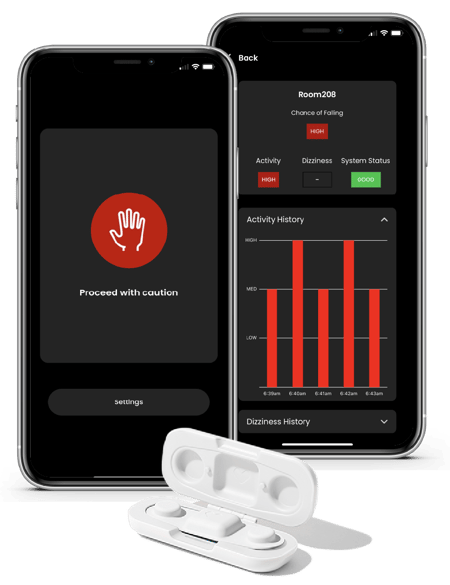The top five significant benefits of preventing falls in hospitals and assisted living care...


 Position change alarms in long-term care have long been considered a standard for patient monitoring and fall prevention. However, as new research sheds light on their limitations, there is a growing call to evaluate their utility for safety vs. their potential psychological and physical impacts on residents. In this article, we’ll discuss the efficacy of position change alarms and compare these devices to new, alternative technology solutions for fall prevention.
Position change alarms in long-term care have long been considered a standard for patient monitoring and fall prevention. However, as new research sheds light on their limitations, there is a growing call to evaluate their utility for safety vs. their potential psychological and physical impacts on residents. In this article, we’ll discuss the efficacy of position change alarms and compare these devices to new, alternative technology solutions for fall prevention.
Position Change Alarms
“Position change alarms are any physical or electronic device that monitors resident movement and alerts the staff when movement is detected. The devices emit an audible signal when the resident moves in certain ways”.
These devices can include chair and bed sensor pads, bedside alarm mats, alarms clipped to a resident’s clothing, seatbelt alarms, and infrared beam motion detectors. However, they exclude devices like door or elevator alarms that monitor unsafe wandering.
The ‘intended’ benefits
Following the Omnibus Reconciliation Act (OBRA) of 1987, bed and chair alarms became the new norm for patient monitoring and fall prevention. The thought process was that these devices would alert staff when a resident or patient attempted to leave their bed or chair unassisted, thus reducing the risk of falls and associated inquiries.
The negative outcomes
While alarms have tremendous lifesaving potential, the persistent sound of beeps and buzzes on unit floors can adversely affect both staff and residents.
Studies suggest that alarms have limited efficacy as fall prevention tools, stating that these devices may only alert a caregiver after a fall has occurred. Alarms may also contribute to increased fall incidences as the noise may startle a resident and cause them to lose their balance. Additionally, the widespread prevalence of false alarms can contribute to “alarm fatigue” among staff, resulting in desensitization and reduced responsiveness to alarms.
Guidance from the Centers for Medicare and Medicaid Services (CMS) suggests that position change alarms may have potential unintended effects akin to a “physical restraint” – as defined as any manual method, physical or mechanical device, equipment, or material that meets all of the following criteria:
- Is attached or adjacent to the resident’s body;
- Cannot be removed easily by the resident, and
- Restricts the resident’s freedom of movement or normal access to his/her body
In essence, these alarms can inhibit a resident’s freedom of movement. For example, a resident may avoid certain repositioning movements or an evening bathroom visit for fear of setting off the alarm and disturbing other residents.
This imposition can lead to a loss of dignity, reduced mobility, bowel and bladder incontinence, and sleep disturbances. Evidence also suggests that alarms create confusion, anxiety, and irritation, adversely affecting residents' quality of life.
The call for de-implementation
In recent years, there has been a widespread movement to phase out personal alarms and other long-used fall prevention measures in favor of more proactive, attentive care.
A cross-sectional interview study with leadership and staff members from seven long-term care facilities links positive outcomes to the de-implementation of alarms, including improved quality of life, less disruptive sleep patterns, and fewer fall incidences among residents.
While there are no formal guidelines for removing alarms from care settings, many leadership teams are actively phasing them out in favor of a calmer, more homelike care environment. With fewer alarms and more innovative patient monitoring solutions, caregivers can better learn residents’ routines and accommodate their needs before they attempt to stand up.
Is OK2StandUP a position change alarm?
No. While OK2StandUP is a monitoring device, it does not “emit an audible signal” when the resident moves in specific ways. Instead, it sends alerts directly to the caregiver's device via a mobile app only when the AI-enabled technology detects a resident’s intention to stand up.
Is OK2StandUP a restraint?
No. The monitor does not restrict the resident’s freedom of movement or access to his/her body. The resident or caregiver can easily remove the monitor at any time.
Additional Benefits
OK2StandUP does not emit an audible signal. Instead, it sends an alert directly to the caregiver's smart device, ensuring that the resident is never disturbed by the device's noise.
OK2StandUP does not signal an alert when a resident is repositioning. The device consistently monitors the wearer’s activity, leveraging machine learning models with a 95% accuracy rate in predicting the adult’s intentions to stand up vs. other common repositioning movements. This predictive aspect allows caregivers to intervene proactively without the hassle of false alarms.
OK2StandUP improves resident safety and well-being. The device offers the same benefits as alarms without the unintended consequences. It is a non-restrictive, non-intrusive fall prevention solution that promotes autonomy and preserves dignity while providing actionable insights and opportunities for proactive intervention.
Preventing falls in long-term care requires a sustained, collaborative effort from interdisciplinary teams. As we strive toward that goal, it’s crucial to reconsider the role of traditional alarms and adopt more effective, evidence-based approaches that help older adults age gracefully and professionals work more efficiently.





